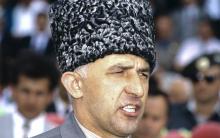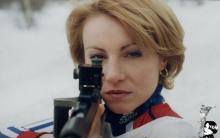THERE IS A THEME
On July 26, the oldest world record in athletics, Jarmila Kratokhvilova’s achievement in the 800 m, will be 30 years old. But Bob Beamon’s long jump record of 8.90, which at one time was called “eternal,” lasted less than 23 years. Currently, the table of world records includes 12 results that will be 25 or more years old this year. Will they be surpassed, and if so, when? Famous athletes and coaches are answering this question today.
MEN
Disk
74,08
Jürgen SCHULT GDR
Neubrandenburg
06.06.1986
The result of Schult, Olympic champion in Seoul 88 and silver medalist in Barcelona 92, is the oldest men's world record in history. Schult, who set his world record at the age of 26 and dominated the men's discus for a long time, competed until he was 40 (that's how old he was in Sydney 2000), received an education in the field of sports and, after finishing his career as an athlete, became a coach.
Yuri DUMCHEV, ex-world record holder:
I think this record will be broken, the only question is when? In the next five, perhaps ten years. Previously, it’s unlikely. Although Pyotr Malakhovsky recently shot at 71.84. In principle, there are good guys who can achieve a world record. But, I repeat, it may well stand for another ten years.
How did I feel about this record? Schult installed it in his hometown, and at the next start he showed almost ten meters less. This alarmed me a little. After that, if I'm not mistaken, he threw 69 many times, but only a few times over 70. It happens: at some point you shoot. Besides, the wind still helps with our species. There are places in the world that seem specially created for discus throwing, where the wind blows very strongly. I know a case where a guy with a personal record of 55 m came to one of these and threw at 65.
Schult's result is, of course, fantastic. At that time it was something! Afterwards I thought that Virgilius Alekna or Gerd Kanter would take him down. The latter, in principle, still has a chance. It seems to me that he is the only one who could do this in the near future. I don’t like Robert Harting from a technical point of view; he has such a typical power throw. But at 75 m it is very difficult to throw like that.
Valentin MASLAKOV , head coach of the Russian national team:
I think this is one of those records that will stand for a long, long time. I don’t see anyone yet who could take a swing at him. Now even throws of just over 70 m are considered a very high result.
HAMMER
86,74
Yuri SEDYKH USSR
Stuttgart
30.08.1988
Yuri Sedykh set his world record at the age of 31 at the European Championships. Before that, his outstanding career included victories at the Games in Montreal '76 and Moscow '80, and later - silver in Seoul '88 and gold in the '91 World Cup. After the collapse of the USSR, Sedykh and his wife, world record holder in shot put Natalya Lisovskaya, lived in France.
Valentin MASLAKOV :
Sedykh had an excellent coach, Anatoly Pavlovich Bondarchuk, who himself threw at a very high level, and then became an excellent mentor. In his group there were several strong athletes who took turns and were leaders. Sedykh, let's say, worked according to his own schedule, which would not suit everyone now: the year showed brilliant results, and the year - rather mediocre. This strategy made it possible to allocate sufficient time for preparation, to perform all the necessary volumes and then show very long throws.
Now in the hammer there are attempts over 83 m. But 86 m is, of course, a very high result. However, I think the record can still be broken. There are athletes who are gradually approaching this mark. Now we see a high density of results. And this is not one or two people, but a whole group that consistently throws in the 82 m area.
WOMEN
100 m
10,49
Florence GRIFFITH-JOYNER USA
Indianapolis
16.07.1988
200 m
21,34
Florence GRIFFITH-JOYNER USA
Seoul
29.09.1988
 Griffith-Joyner continues to impress today. Not only for her phenomenal running and incredible career rise, which happened to her quite late by athletics standards - at 29 years old. But also an appearance that can decorate any girl’s pop group, extravagant tights on one leg and much more. Her tragic death at age 38 under mysterious circumstances (the official cause of death was a heart attack, but many continue to doubt this to this day) only cemented Griffith-Joyner’s status as a mysterious legend.
Griffith-Joyner continues to impress today. Not only for her phenomenal running and incredible career rise, which happened to her quite late by athletics standards - at 29 years old. But also an appearance that can decorate any girl’s pop group, extravagant tights on one leg and much more. Her tragic death at age 38 under mysterious circumstances (the official cause of death was a heart attack, but many continue to doubt this to this day) only cemented Griffith-Joyner’s status as a mysterious legend.
Many tried to challenge Florence’s results. There is an opinion that the 100-meter race in Indianapolis was run with a strong tailwind, which for some reason was not recorded by the equipment. However, the second result of Griffith-Joyner (10.61), shown with permissible wind indicators, would still be a world record.
Lyudmila KONDRATIEVA , Olympic champion of Moscow-80 in the 100-meter dash, bronze medalist of Seoul-88 in the 4x100 m relay:
Griffith-Joyner is, of course, a legendary figure. Now there is no one to compare her with. She didn’t run - she flew like a bird, sprucing up and touching the path.
We didn't know each other personally. But I remember that at the Olympics in Seoul, during the races, there was no one to pin her number on her back. And she asked me - the closest one standing nearby. Even my little hands began to tremble - to pin a number on such a star. I was very pleased.
Of course she stood out. So stylish, always very well-groomed. These long nails, unusual overalls, extravagant outfits... She loved to experiment and was not shy about wearing some revealing things. Even in everyday life, I always dressed unusually. We were still young then and looked with all our eyes: wow, she’s so talented and at the same time so extravagant. I would call her a trendsetter.
The results shown by Florence are truly outstanding, what more can I say. Maybe someone will surpass them. But it seems to me that this will not happen soon. I would like, of course, to be wrong, but... The runners are now closer to her, especially at 200 m, but just a little. And at 100 m - even less. Maybe one day such a Bolt will appear in a female guise in America or Jamaica - there has just been a championship there, and the results in the sprint are very high for both women and men.
Valentin MASLAKOV :
These are fantastic records. Although the American women are running well now, Jamaica is “waking up”. I think it will be especially difficult to break the 200m record. Still, 21.34 is a very high result for women. But in the 100-meter dash, I think one of the girls can surpass him.
400 m
47,60
Marita KOCH GDR
Canberra
06.10.1985
Marita Koch is best spoken for by her impressive statistics. Olympic champion, three-time world champion, who holds a total of 15 world records. She set the world record for 400 m at the age of 28. At one time, there were certain questions about Koch, like all representatives of the GDR, but Marita categorically denied all suspicions.
“I was relatively diligent, but not super-ambitious,” Koch said about herself in an interview with SE. “If necessary, I worked 120 percent and could be quite tough on myself. And height, weight - it was all about.” kay. My technique was also good - my running style was formed from childhood. I was quite strong, powerful - it’s important that my bones can withstand. Of course, I was happy when I set a record. At the same time, I understood that someday they would break it too. There are no eternal records.
Running 400 meters quickly takes a lot of work. You won’t set a record here easily or by accident. An athlete must run consistently over 48-something for a couple of years, and only then, perhaps, will she be able to make a breakthrough. Before I broke 48 seconds, I ran the 400-meter dash for 11 years, improving my results almost every year. Could I have run faster than 47.60? Probably not. Everything worked out optimally that day."
Valentin MASLAKOV :
Koch is a brilliant athlete in every way. Very talented. In addition, she had excellent preparation methods and pharmacological support. And all this, as they say, suited her very well. At one time, I conducted a lot of joint training with the Germans and I can say that it really worked in a new way, not the way everyone else trained at that time. I think her record will stand for a long, long time. Nowadays, female athletes can “run out” of 49 seconds, but 47 is, in our times, almost a man’s result.
800 m
1.53,28
Jarmila KRATOCHVILOVA Czechoslovakia
Munich
26.07.1983
The record of the then 32-year-old Kratokhvilova, set at a competition in Munich, is the longest-lived world achievement among women. She also once held the world record in the 400-meter dash (47.99), which was then taken by Marita Koch. At one time, the South African Caster Semenya was called the heiress of the Czechoslovakian athlete. After her impressive victory at the 2009 World Cup in Berlin, talk of a possible fall in Kratokhvilova's record was more popular than ever. However, the almost year-long investigation into Semenya's gender identity appears to have put an end to this story.
Valentin MASLAKOV :
I think that a new world record is not expected in this discipline in the near future. Although Caster Semenya could install it. Moreover, I know that she was aiming for this, she wanted to do it. Is she capable of this now, after returning to the track? I have the impression that now she is “burying” herself a little so as not to stand out too much.
Relay race 4x400 m
3.15,17
USSR
Tatiana LEDOVSKAYA
Olga NAZAROVA
Maria PINIGINA
Olga BRYZGINA
Seoul
01.10.1988
In recent years, this type of program has become a real super battle between the Russian and American teams. This is only to our advantage: in such conditions there is every chance of a new world record. We hope, of course, that victory here, as in the Olympic Seoul, will remain ours.
Valentin MASLAKOV :
This result, in principle, cannot be called some kind of fantastic. It’s just that at that time we had a very good quartet - all the girls ran around 49 seconds. If we put together a company like this now, we could have a new global one. And one day such a quartet will definitely come together. Not only we, but also the American women are showing strong results. For a long time they did not pay enough attention to relay races, considering personal events more prestigious. But now the psychology is changing, and not only for them. For example, Englishwomen are very interested in relay races.
100 m s/b
12,21
Jordanka DONKOVA Bulgaria
Stara Zagora
20.08.1988
 Donkova’s highest world achievement, set in the year of her 27th birthday, recently almost left the list of long-lived records. On June 22, at the US Championships, 21-year-old American Brianna Rollins showed a result of 12.26, making several obvious mistakes. In view of this (Rollins knocked down one barrier and hit five more), as well as the athlete’s youth and lack of experience, everyone immediately started talking about the fact that Donkova’s record, apparently, is now first in line for “withdrawal.”
Donkova’s highest world achievement, set in the year of her 27th birthday, recently almost left the list of long-lived records. On June 22, at the US Championships, 21-year-old American Brianna Rollins showed a result of 12.26, making several obvious mistakes. In view of this (Rollins knocked down one barrier and hit five more), as well as the athlete’s youth and lack of experience, everyone immediately started talking about the fact that Donkova’s record, apparently, is now first in line for “withdrawal.”
Valentin MASLAKOV :
Americans generally don’t hold their championships in bad conditions when something gets in the way. This is done just to show good results. And Rollins almost broke Donkova’s record. For this, of course, ideal conditions are needed. But I think if everything works out for her at a certain point, she is able to do this in the foreseeable future. So here we have every reason to be hopeful.
Height
2,09
Stefka KOSTADINOVA Bulgaria
Rome
30.08.1987
 Kostadinova made her legendary jump at the age of 22 - and it was miraculously good, just like the blonde athlete herself. This world record, one of the oldest in women's athletics, has understandably attracted special attention in Russia since Anna Chicherova's winning streak began. Chicherova’s outstanding mentor Evgeniy Zagorulko has repeatedly hinted that the legendary Bulgarian’s achievement is achievable. And Chicherova herself said this about this last fall: “Some time ago I couldn’t even think about any world record. But last year in Brussels I jumped 2.10. And you know what? This record was very close. Yes, it really can be broken! And then, 25 years is too long for a world record."
Kostadinova made her legendary jump at the age of 22 - and it was miraculously good, just like the blonde athlete herself. This world record, one of the oldest in women's athletics, has understandably attracted special attention in Russia since Anna Chicherova's winning streak began. Chicherova’s outstanding mentor Evgeniy Zagorulko has repeatedly hinted that the legendary Bulgarian’s achievement is achievable. And Chicherova herself said this about this last fall: “Some time ago I couldn’t even think about any world record. But last year in Brussels I jumped 2.10. And you know what? This record was very close. Yes, it really can be broken! And then, 25 years is too long for a world record."
Valentin MASLAKOV :
If it was just one jump, one could say that everything just came together for Kostadinova that day. But she had a lot of such jumps! So there is no question of any accident here. And yet I believe that an athlete may appear who will jump higher. Including among our girls. The same Anna Chicherova can easily do this. There is also young Maria Kuchina, who has very good potential.
Length
7,52
Galina CHISTYAKOVA USSR
Leningrad
11.06.1988
 Another domestic record was set at the Znamensky Memorial and has since inspired a considerable number of athletes to take up long jumping. “I thought that if I moved the takeoff 10 cm closer, it would be enough to jump 7.50,” says Chistyakova herself, who was 25 years old at the time, in June 1988, about her legendary jump. “And so it happened.” “That is, this jump was absolutely under control. Not at full strength, but under control.”
Another domestic record was set at the Znamensky Memorial and has since inspired a considerable number of athletes to take up long jumping. “I thought that if I moved the takeoff 10 cm closer, it would be enough to jump 7.50,” says Chistyakova herself, who was 25 years old at the time, in June 1988, about her legendary jump. “And so it happened.” “That is, this jump was absolutely under control. Not at full strength, but under control.”
Like other Soviet world record holders - Sedykh and Lisovskaya, Chistyakova ended up abroad after the collapse of the USSR. Now she has been living with her family in Slovakia for many years. Gives master classes for children.
Tatiana LEBEDEVA , Olympic champion:
In those days, when Heike Drechsler, Chistyakova, Jackie Joyner-Kersee competed among themselves, it seemed that girls would be able to jump 8 m. But since then the sport has changed a lot. Doping control has become stricter, the environment has become worse: look what we eat, what we breathe. There has also become more commerce - athletes can no longer afford to throw all their energy into one competition.
I once talked with my husband and coach Chistyakova, and he said that if they had started developing the triple jump a little earlier, Galina would have jumped 16 m. After all, even when her results had already begun to decline, when she began to suffer from injuries and was not developed training method, she jumped 14.70. Perhaps in the triple, Chistyakova could realize herself even more.
Even to me, an Olympic champion, the long jump of 7.50 seems fantastic. Now even if you jump over 7 m, this is already considered a grandmaster result.
Is it realistic to break Chistyakova’s record in the future? London Olympic champion Brittney Rees has a 7.25 this season, but I don't think she's capable of breaking the world record. After all, Reese is already a fairly experienced athlete. Her physical characteristics are excellent, even phenomenal, but psychologically she has not matured during this time. Reese is unstable. At one start he can jump 7.25, and at another - 5.90. And although after jumping 7.25, Reese promised to break the world record, for now it sounds a little funny. 7.25 and 7.50 - for the long jump this is heaven and earth.
Of the current athletes, I would only bet on Blessing Okagbare from Nigeria. At the age of 19, she completely unexpectedly became third in Beijing. Young, no load - she ran and jumped 6.93, setting a personal record. Then she focused on the sprint, became more powerful and now has very good results. But sometimes he continues to indulge in long jumps. Of course, it has a whole bunch of technical flaws - it takes its toll due to its phenomenal speed. But if Blessing focuses on length, tweaks her technique, and gets a little dryer, she could break the world record.
Core
22,63
Natalia LISOVSKAYA USSR
Moscow
07.06.1987
 Another “home” world achievement: the then 24-year-old Lisovskaya established her final world achievement (there were two more before it, several years earlier) at the Moscow Druzhba stadium.
Another “home” world achievement: the then 24-year-old Lisovskaya established her final world achievement (there were two more before it, several years earlier) at the Moscow Druzhba stadium.
Valentin MASLAKOV :
Lisovskaya confidently pushed the shot at 20-21 m, so this was not the limit for her. Moreover, at that time her results were much higher, they were simply not included in official statistics. Let's say the results shown at home were not very welcome.
Can anyone get closer to Lisovskaya's record? There is a New Zealander, Valerie Adams, who consistently pushes beyond 20 m. But she is from the singles category, and in general the results are much lower. Theoretically, the New Zealander is probably capable of setting a world record. But now, when athletes are subject to increasingly strict control, it is difficult. I think that for Adams it is much easier to calmly push beyond 20 m and emerge victorious than to chase some kind of records and then, God forbid, put your name and reputation at risk.
Disk
76,80
Gabriela RAINCH GDR
Neubrandenburg
09.07.1988
The then 24-year-old Reinsch set her world record, which turns 25 this year, on July 9, 1988 during an athletics match between Italy and the GDR. That season she improved her personal best by almost 10 meters. Paradoxically, in addition to the world record, the athlete’s highest achievements in her career were 2nd place at the Junior European Championships in the shot put, 2nd place at the Universiade-87 (discus) and 4th at the European Championships-90 (discus). At the Olympics in Seoul, Reinsch remained only seventh with a score of 67.26.
Gabriela almost lost the main sporting achievement of her life. In September of the same 1988, Martina Hellmann showed even more distant throws in discus throwing. But due to the unofficial status of those starts, the world record remained with Reinsch.
Yuri DUMCHEV:
I know that German women threw many times in the area of 72-74 m. I myself have seen such throws many times. The female disc is an unpredictable species. It hit well - that's all!
Of course, 76.80 is a crazy result. For this to happen, absolutely everything must work out. For example, I had training results when I threw 77 m, many times, and even 78 m. But this was during training!
Valentin MASLAKOV :
This result is another legacy of the GDR, when everything and even more was done for achievements in sports. There was a whole system working for this. I don’t believe that Reinsch’s record will be broken. Now even throws beyond 67 m are considered a super result.
Heptathlon
7291 points
Jackie JOYNER-KERSEY USA
Seoul
24.09.1988
The breakdown of the record for Joyner-Kersee (26 years old), a representative of the legendary family of American athletics, is as follows: 12.69 (100 m s/b), 1.86 m (height), 15.80 m (core), 22.56 (200 m), 7.27 m (length), 45.66 m (spear), 2.08.51 (800 m). Joyner-Kersee managed to become not only a legendary heptathlete, but also wrote her name in the history of the long jump. The outstanding athlete, who managed to become an Olympic champion in two types of programs within the framework of one Games, holds the second result in the history of this event - 7.49 m.
Tatiana LEBEDEVA :
Jackie was very well built, athletic, and had excellent speed. And these strengths were developed through training. If an all-around athlete has speed, she is good at jumping, hurdles, and other events.
In general, Joyner-Kersee is ideal for me in terms of technique in the long jump. At one time we tried to copy it. She had a three and a half step way - not every man can do that. To successfully perform this, a person must fly at least 7 m. I know from myself: when I’m ready at 7 m, I can do it, but when only at 6.60, I already get an incomprehensible flickering. The flight phase is only a fraction of a second shorter, but you no longer have time to gather your legs in order to finally throw them correctly for landing.
Valentin MASLAKOV :
7291 points is, of course, a very high result. But not so much that he couldn't be beaten. Our Tatyana Chernova or Englishwoman Jessica Ennis can easily do this. For example, Chernova puts the shot at 13 m, but if she put the shot at 16, like some of her competitors, the result would be completely different. I think one day there will definitely be an athlete who can surpass Joyner-Kersee’s achievement.











The most beautiful motorcycles in the world
Which sea is the cleanest in the world?
Top 10 Most Expensive Furs
The largest and most luxurious casinos in the world
Knightly orders of Europe XI - XIII centuries